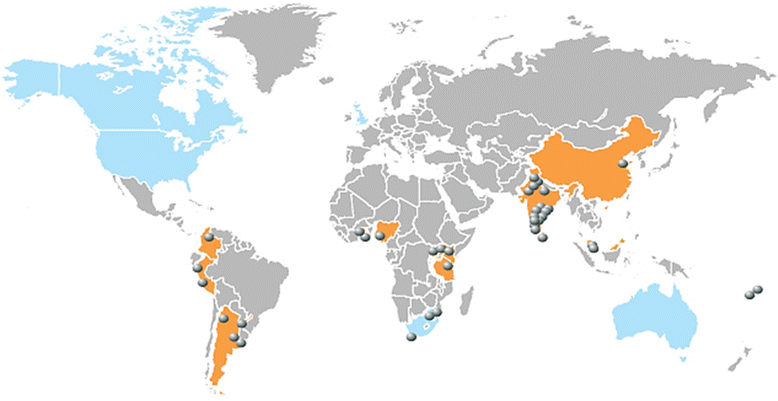Developing consensus measures for global programs: lessons from the Global Alliance for Chronic Diseases Hypertension research program
- PMID: 28298233
- PMCID: PMC5353794
- DOI: 10.1186/s12992-017-0242-8
Developing consensus measures for global programs: lessons from the Global Alliance for Chronic Diseases Hypertension research program
Abstract
Background: The imperative to improve global health has prompted transnational research partnerships to investigate common health issues on a larger scale. The Global Alliance for Chronic Diseases (GACD) is an alliance of national research funding agencies. To enhance research funded by GACD members, this study aimed to standardise data collection methods across the 15 GACD hypertension research teams and evaluate the uptake of these standardised measurements. Furthermore we describe concerns and difficulties associated with the data harmonisation process highlighted and debated during annual meetings of the GACD funded investigators. With these concerns and issues in mind, a working group comprising representatives from the 15 studies iteratively identified and proposed a set of common measures for inclusion in each of the teams' data collection plans. One year later all teams were asked which consensus measures had been implemented.
Results: Important issues were identified during the data harmonisation process relating to data ownership, sharing methodologies and ethical concerns. Measures were assessed across eight domains; demographic; dietary; clinical and anthropometric; medical history; hypertension knowledge; physical activity; behavioural (smoking and alcohol); and biochemical domains. Identifying validated measures relevant across a variety of settings presented some difficulties. The resulting GACD hypertension data dictionary comprises 67 consensus measures. Of the 14 responding teams, only two teams were including more than 50 consensus variables, five teams were including between 25 and 50 consensus variables and four teams were including between 6 and 24 consensus variables, one team did not provide details of the variables collected and two teams did not include any of the consensus variables as the project had already commenced or the measures were not relevant to their study.
Conclusions: Deriving consensus measures across diverse research projects and contexts was challenging. The major barrier to their implementation was related to the time taken to develop and present these measures. Inclusion of consensus measures into future funding announcements would facilitate researchers integrating these measures within application protocols. We suggest that adoption of consensus measures developed here, across the field of hypertension, would help advance the science in this area, allowing for more comparable data sets and generalizable inferences.
Keywords: Consensus Measures; Hypertension; Implementation; Implementation Context; Low and middle income countries.
Figures


References
-
- Brown IJ, Dyer AR, Chan Q, Cogswell ME, Ueshima H, Stamler J, Elliott P, Group IC-OR. Estimating 24-hour urinary sodium excretion from casual urinary sodium concentrations in Western populations: the INTERSALT study. Am J Epidemiol. 2013;177(11):1180–1192. doi: 10.1093/aje/kwt066. - DOI - PMC - PubMed
-
- Yusuf S, Hawken S, Ounpuu S, Dans T, Avezum A, Lanas F, McQueen M, Budaj A, Pais P, Varigos J, et al. Effect of potentially modifiable risk factors associated with myocardial infarction in 52 countries (the INTERHEART study): case–control study. Lancet. 2004;364(9438):937–952. doi: 10.1016/S0140-6736(04)17018-9. - DOI - PubMed
-
- Peyrot M, Rubin RR, Lauritzen T, Snoek FJ, Matthews DR, Skovlund SE. Psychosocial problems and barriers to improved diabetes management: results of the Cross-National Diabetes Attitudes, Wishes and Needs (DAWN) Study. Diabet Med. 2005;22(10):1379–1385. doi: 10.1111/j.1464-5491.2005.01644.x. - DOI - PubMed
-
- The Global Fund [http://www.theglobalfund.org/en/]
MeSH terms
Grants and funding
LinkOut - more resources
Full Text Sources
Other Literature Sources
Medical

